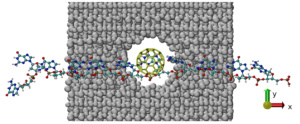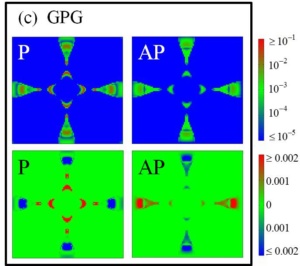The spin degree of freedom is today as important as the electrical charge in electronic applications. These include for instance the read-heads of hard-disk drives and a multitude of magnetic field sensors. The Computational Spintronics Group has a long-standing unique experience in studying the interplay between electrical currents and magnetic order in solid state devices. Here are a few on-going projects in this area:
Ab initio charge and spin transport in nano-devices
 In the last 10 years the Computational Spintronics Group has developed a world-leading expertise in designing algorithms for electron transport at the nanoscale [1,2,3]. In particular we have created the code, Smeagol, which combines density functional theory with the non-equilibrium Green’s functions method for quantum transport, and allows one to simulate the electrical response of nano-scale devices from first principles (no parameters needed). Over the years Smeagol has been a key tool for simulating devices of both fundamental and industrial interest. In particular, we have predicted the co-existence of giant electro-resistance and giant magnetic-resistance in multiferroic spin-valves [1], evaluated the device constrains limiting the sensitivity of bio-chemical sensors (DNA sequencing) [2], simulated scanning tunnelling microscope images of atomic adsorbates on surfaces [3], and designed spin-optoelectronic devices [4]. Recently we have developed numerical implementations of Smeagol capable of large-scale simulations, where the typical simulation cells can contain several thousand atoms. The code is freely distributed to academia and at present counts in excess of 200 licensed users, distributed over 5 continents.
In the last 10 years the Computational Spintronics Group has developed a world-leading expertise in designing algorithms for electron transport at the nanoscale [1,2,3]. In particular we have created the code, Smeagol, which combines density functional theory with the non-equilibrium Green’s functions method for quantum transport, and allows one to simulate the electrical response of nano-scale devices from first principles (no parameters needed). Over the years Smeagol has been a key tool for simulating devices of both fundamental and industrial interest. In particular, we have predicted the co-existence of giant electro-resistance and giant magnetic-resistance in multiferroic spin-valves [1], evaluated the device constrains limiting the sensitivity of bio-chemical sensors (DNA sequencing) [2], simulated scanning tunnelling microscope images of atomic adsorbates on surfaces [3], and designed spin-optoelectronic devices [4]. Recently we have developed numerical implementations of Smeagol capable of large-scale simulations, where the typical simulation cells can contain several thousand atoms. The code is freely distributed to academia and at present counts in excess of 200 licensed users, distributed over 5 continents.
References:
Spin-transfer torques from first principles
 The magnetic state of a device affects its resistance because of the interaction between the current-carrying charges and the local magnetization. This gives rise to a multitude of transport phenomena, including the giant and tunnelling magnetoresistance. However, also the opposite is true, namely that a spin-polarized current when passing through a material with a magnetic texture exerts a torque on the local magnetic moment. When the torque is strong enough such current can induce magnetization dynamics, for instance producing magnetization switching or sustaining precession against dissipation. This phenomenon, known as spin-transfer torque, offers a great potential for fabricating current-operated devices. The description of all spin-transfer torques is usually carried out by empirical/approximated models, which all require parameters specific of the given material. Recently we have developed a method, based on time-dependent density functional theory and then adapted to the open-boundary conditions transport problem, capable of extracting spin-transfer torques from first principles. The method has been implemented in the Smeagol code and it is capable of computing the spin transfer torque with atomic resolution. Furthermore, since it is integrated in an electron transport code, it can provide the torque as a function of bias and not only of the current density.
The magnetic state of a device affects its resistance because of the interaction between the current-carrying charges and the local magnetization. This gives rise to a multitude of transport phenomena, including the giant and tunnelling magnetoresistance. However, also the opposite is true, namely that a spin-polarized current when passing through a material with a magnetic texture exerts a torque on the local magnetic moment. When the torque is strong enough such current can induce magnetization dynamics, for instance producing magnetization switching or sustaining precession against dissipation. This phenomenon, known as spin-transfer torque, offers a great potential for fabricating current-operated devices. The description of all spin-transfer torques is usually carried out by empirical/approximated models, which all require parameters specific of the given material. Recently we have developed a method, based on time-dependent density functional theory and then adapted to the open-boundary conditions transport problem, capable of extracting spin-transfer torques from first principles. The method has been implemented in the Smeagol code and it is capable of computing the spin transfer torque with atomic resolution. Furthermore, since it is integrated in an electron transport code, it can provide the torque as a function of bias and not only of the current density.
References:
[2] Maria Stamenova, Razie Mohebbi, Jamileh Seyed-Yazdi, Ivan Rungger, and Stefano Sanvito. First-principles spin-transfer torque in CuMnAs|GaP|CuMnAs junctions. Phys. Rev. B 95, 060403(R) (2017). [1] Yunkun Xie, Ivan Rungger, Kamaram Munira, Maria Stamenova, Stefano Sanvito and Avik W. Ghosh, Spin Transfer Torque: A Multiscale Picture, in “Nanomagnetic and Spintronic Devices for Energy-Efficient Memory and Computing”, Wiley (2016).
Multi-scale theory of current induced spin relaxation
In a spin device, such as a magnetic tunnel junction, the on-set of the steady state current is orders of magnitude faster than the times typical for the magnetization dynamics. This gives us the opportunity to construct a multi-scale theory for current-induced magnetization dynamics. The idea is to use the current-induced torques calculated for specific devices by mean of ab initio transport theory (see above) with micromagnetics simulators. In particular we have implemented an interface between our DFT quantum transport code Smeagol and the atomistic micromagnetics simulator, Vampire. Such tool enables us to compute the switching times of a given junction (at the moment we are looking at both GMR and TMR devices) as a function of the device operating parameters, such as the bias voltage. Additional work is on-going to construct interfaces with finite-element simulators. Our multi-scale approach allows us to perform time-dependent simulations for real devices without the need of free parameters.
Time-dependent DFT for ultra-fast spin dynamics
 More than a decade ago it was demonstrated that an intense laser pulse can drastically supress the magnetization of a magnetic material on the time-scale of a few picoseconds. Such time-scale is too fast to justify heating into the system and a multitude of theories have been brought forward to explain the phenomenon. These include direct coupling to the laser field and various spin-diffusion mechanisms. Here we have taken a different approach, namely we have performed real-time time-dependent DFT simulations of magnetic materials, either clusters or bulk transition metals, irradiated with very intense laser fields. Our simulations are valid in the first few femptoseconds of the dynamics where dissipative effects are not at play. Importantly, we have identified the key ingredients of the de-magnetization phenomena, namely the necessity of having spin-orbit interaction and ultra-fast currents. This area of research has been also extended to metallic heterostructures and it is touching very fundamental aspects of quantum mechanics such as the conservation of the total angular momentum in a quantum mechanical system.
More than a decade ago it was demonstrated that an intense laser pulse can drastically supress the magnetization of a magnetic material on the time-scale of a few picoseconds. Such time-scale is too fast to justify heating into the system and a multitude of theories have been brought forward to explain the phenomenon. These include direct coupling to the laser field and various spin-diffusion mechanisms. Here we have taken a different approach, namely we have performed real-time time-dependent DFT simulations of magnetic materials, either clusters or bulk transition metals, irradiated with very intense laser fields. Our simulations are valid in the first few femptoseconds of the dynamics where dissipative effects are not at play. Importantly, we have identified the key ingredients of the de-magnetization phenomena, namely the necessity of having spin-orbit interaction and ultra-fast currents. This area of research has been also extended to metallic heterostructures and it is touching very fundamental aspects of quantum mechanics such as the conservation of the total angular momentum in a quantum mechanical system.
References:
[3] J. Simoni, M. Stamenova, and S. Sanvito. Ultrafast demagnetizing fields from first principles. Phys. Rev. B 95, 024412 (2017). [2] Alexandr Alekhin, Ilya Razdolski, Nikita Ilin, Jan P. Meyburg, Detlef Diesing, Vladimir Roddatis, Ivan Rungger, Maria Stamenova, Stefano Sanvito, Uwe Bovensiepen, and Alexey Melnikov. Femtosecond Spin Current Pulses Generated by the Nonthermal Spin-Dependent Seebeck Effect and Interacting with Ferromagnets in Spin Valves. Phys. Rev. Lett. 119, 017202 (2017). [1] Maria Stamenova, Jacopo Simoni, and Stefano Sanvito. Role of spin-orbit interaction in the ultrafast demagnetization of small iron clusters. Phys. Rev. B 94, 014423 (2016).
